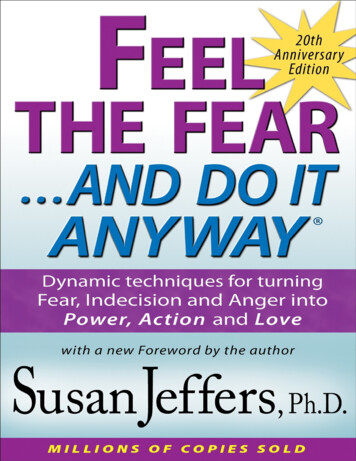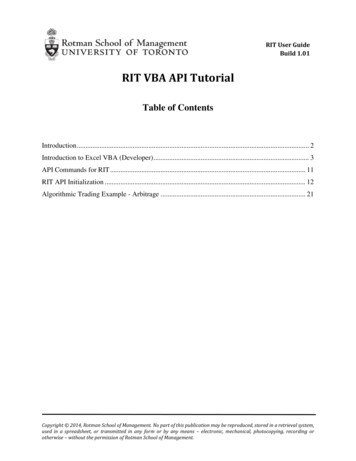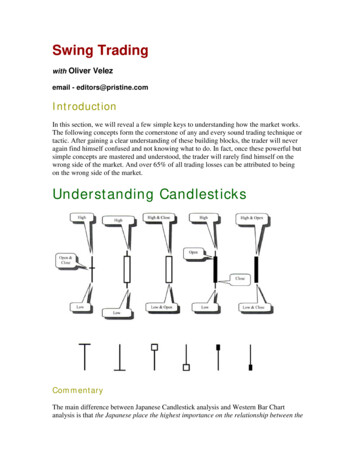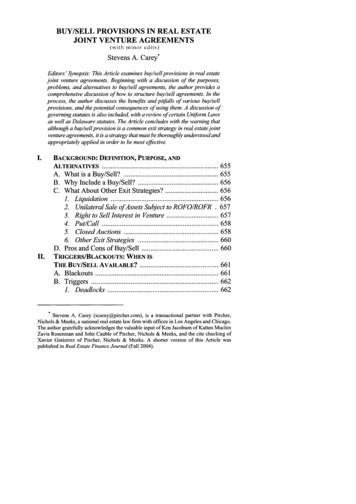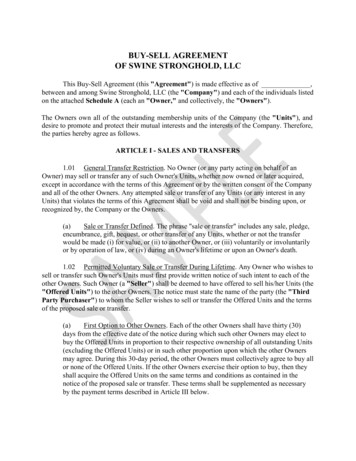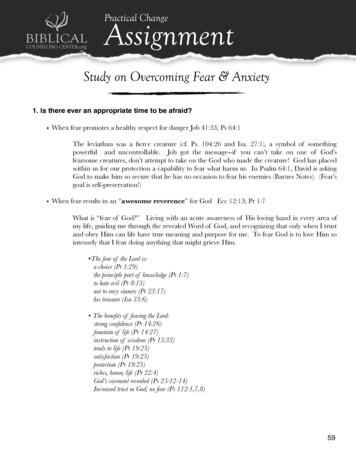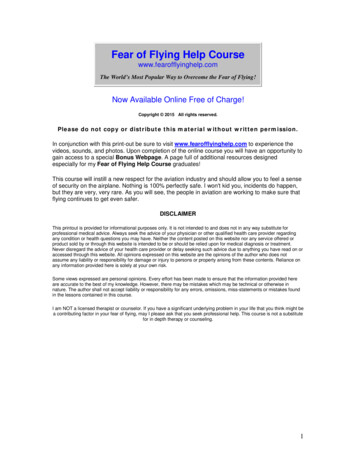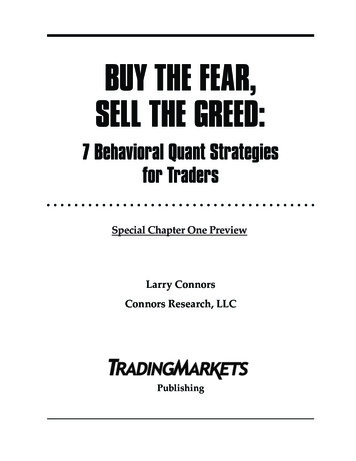
Transcription
Buy the Fear,Sell the Greed:7 Behavioral Quant Strategiesfor tradersSpecial Chapter One Previewlarry ConnorsConnors research, llCPublishing
Copyright 2018, Laurence A. Connors and Connors Research, LLC.ALL RIGHTS RESERVED. No part of this publication may be reproduced, stored in aretrieval system, or transmitted, in any form or by any means, electronic, mechanical,photocopying, recording, or otherwise, without the prior written permission of the publisher and the author.This publication is designed to provide accurate and authoritative information in regardto the subject matter covered. It is sold with the understanding that the author and thepublisher are not engaged in rendering legal, accounting, or other professional service.Authorization to photocopy items for internal or personal use, or in the internal or personal use of specific clients, is granted by The Connors Group, Inc., provided that the U.S. 7.00 per page fee is paid directly to The Connors Group, Inc., 1-973-494-7311.Publisher’s NoticeThe publisher has provided this eBook to you without Digital Rights Management (DRM)software applied so that you can enjoy reading it on your personal devices. This eBookis for your personal use only. You may not print or post this eBook, or make this eBookpublicly available in any way. You may not copy, reproduce, or upload this eBook exceptto read it on your personal devices.Copyright infringement is against the law. If you believe the copy of this eBook you arereading infringes on the author’s copyright, please notify the publisher at info@cg3.com.ISBN 978-0-578-20650-9EBook ISBN 978-0-578-20651-6Printed in the United States of America.
DisclaimerThe Connors Group, Inc., Connors Research and Laurence A. Connors (collectively referred to as “Company”) are not investment advisory services, nor registered investmentadvisors or broker-dealers and do not purport to tell or suggest which securities orcurrencies customers should buy or sell for themselves. The analysts and employees oraffiliates of Company may hold positions in the stocks, currencies or industries discussedhere. You understand and acknowledge that there is a very high degree of risk involvedin trading securities and/or currencies. The Company, the authors, the publisher, and allaffiliates of Company assume no responsibility or liability for your trading and investment results. Factual statements on the Company’s website, or in its publications, aremade as of the date stated and are subject to change without notice.It should not be assumed that the methods, techniques, or indicators presented in theseproducts will be profitable or that they will not result in losses. Past results of any individual trader or trading system published by Company are not indicative of future returnsby that trader or system, and are not indicative of future returns which be realized byyou. In addition, the indicators, strategies, columns, articles and all other features ofCompany’s products (collectively, the “Information”) are provided for informational andeducational purposes only and should not be construed as investment advice. Examplespresented on Company’s website are for educational purposes only. Such set-ups are notsolicitations of any order to buy or sell. Accordingly, you should not rely solely on theInformation in making any investment. Rather, you should use the Information only asa starting point for doing additional independent research in order to allow you to formyour own opinion regarding investments. You should always check with your licensedfinancial advisor and tax advisor to determine the suitability of any investment.HYPOTHETICAL OR SIMULATED PERFORMANCE RESULTS HAVE CERTAININHERENT LIMITATIONS. UNLIKE AN ACTUAL PERFORMANCE RECORD,SIMULATED RESULTS DO NOT REPRESENT ACTUAL TRADING AND MAY NOT BEIMPACTED BY BROKERAGE AND OTHER SLIPPAGE FEES. ALSO, SINCE THE TRADESHAVE NOT ACTUALLY BEEN EXECUTED, THE RESULTS MAY HAVE UNDER- OROVER-COMPENSATED FOR THE IMPACT, IF ANY, OF CERTAIN MARKET FACTORS,SUCH AS LACK OF LIQUIDITY. SIMULATED TRADING PROGRAMS IN GENERALARE ALSO SUBJECT TO THE FACT THAT THEY ARE DESIGNED WITH THE BENEFITOF HINDSIGHT. NO REPRESENTATION IS BEING MADE THAT ANY ACCOUNTWILL OR IS LIKELY TO ACHIEVE PROFITS OR LOSSES SIMILAR TO THOSE SHOWN.The Connors Group, Inc.185 Hudson St.Suite 2500Jersey City, NJ 07311Connors Research, LLC185 Hudson St.Suite 2500Jersey City, NJ 07311
8910Fear, Greed, and Markets xi1RSI PowerZones 19CRASH35Volatility Trading 55Vol Panics 69VXX Trend Strategy 83Trading New Highs 95TPS; Fear and Greed Rising 107Terror Gaps 125Buying Fear, Selling Greed 135vii
Appendix149i.Connors Research Traders Journal (Volume 7):Superior Trade Construction for Asymmetrical Gains 149ii.Connors Research Traders Journal (Volume 3):Stops (Still) Hurt 154iii.AmiBroker Add-on Code for the TradingStrategies in Buy the Fear, Sell the Greed157iv.More Research from Larry Connors 158v.Private Mentoring 159vi.Private Consulting for Asset Managers and Family Offices 160vii.Introduction to AmiBroker Programming 161viii. Correlation Risk 164ix.Trading Resources 166x.Relative Strength Indicator Formulaand ConnorsRSI Calculation 173ix
AcknowledgmentsAs with all of the books we have published over the years, this one requireda team of dedicated individuals to get it from a raw manuscript to the finished product you now hold in your hands.A special thank you from me to the following people who assisted in thecreation of this book.Cesar Alvarez, Brittany Connors, Drew Markson, Lani Meyer, Jason Meyer,Matt Radtke, Jose Pepito, Jr., Shuma Malik, and Danilo Torres.xi
Chapter1Fear, Greed, and Markets“In war tomorrow, we shall be dealing with men subject to the sameemotions as were the soldiers of Alexander.”George S. PattonFrom George Patton’s Personal PapersThe Secrets to VictoryMarch 26, 1926Let’s imagine you’re asking for professional advice on an important financial matter from someone who is experiencing the following symptoms: NauseaDizzinessChest painHeadachesNeck achesStomach upsetPulsing in the earBurning skinShortness of breath1
2Chapter 1 Electric shock feelingShooting pains in the faceHeart palpitationsWeakness in legsFeelings of going crazyFear of impending doomOn a scale of 1-10, how confident are you of this person’s judgment?8-10 - Highly confident. This guy definitely has his act together.5-7 - Somewhat confident. Maybe the shooting pains in his face and hisheart palpitations are a bit bothersome, but you’re willing to overlook everything else, including his feelings of burning skin, nausea, dizziness, andthe weakness in his legs.2-4 - Little confidence. Feelings of going crazy and fear of impending doomare not quite the qualities that inspire strength and confidence in someone’sjudgment in making financial decisions for you.1 - None. Nada. Nul. Nicht. ZERO! The guy’s likely a nut. Who in their rightmind would rely on the judgment of a person in this condition?The Correct AnswerYou likely answered either 2-4 or 1 (OK, I know you answered 1).The OfferNow let’s assume I make the following offer to you: I offer you the chanceto trade directly against traders and investors who are having the exactsymptoms listed above, including the feelings of going crazy and impending doom. And as a bonus 1. You can trade one-on-one against them;
Fear, Greed, and Markets2. You get to determine the times you’ll trade against them;3. You get to construct the trade however you feel is best for you;4. And you get to do this multiple times every month for the rest of yourlife. On top of this you know that had you done this over the past quarter century, you would have won anywhere from over 70% of the timeto up to 97% of the times you did this.How does this make you feel? Would you accept this offer?Most people certainly would and I’m sure you would too. This book isgoing to show you when, where, and how to do this.So now I’m sure you’re excited. You’re also saying to yourself, “What’s thecatch? This sounds too good to be true.”Well, it’s true. You’ll see that quantitatively for years and even decades it’sbeen true. The catch is that the times you will be buying and selling thesehistorically large-edge high-probability times are psychologically the hardest times to take these trades. This is why the edges you are about to learnhave existed for years and, in many cases, decades.Unfortunately, many traders and investors are psychologically unable tofully take advantage of these types of opportunities. (Warren Buffett canand does on the investment side, but this is a big part of why Buffett isBuffett.)The outside fear when these trading opportunities occur is often too extreme and when fear is too extreme, the crippling symptoms mentionedearlier kick in and one normally goes into protection mode. Traders andinvestors are usually not willing or able to shut off the noise to go intooffensive mode. You’ll see this throughout this book — there are manybehavioral components going on at the same time and none add up to onerationally saying to themselves, “It’s time to buy.” In fact, the majority ofrational people are in panic mode pushing prices even lower and makingedges even greater for those who step in at the right time.Click here to order your copy of Buy The Fear; Sell The Greed 7 Behavioral Quant Strategies For Traders3
4Chapter 1The goal of this book is to make you aware of when and why short-termmarket edges exist in stocks and in ETFs, and then give you the quantifiedstrategies to trade them.I wrote my first book on trading more than two decades ago and have sinceauthored a half dozen more books. Each book contained either strategiesand/or years of price data that showed where trading edges exist.Over the past five years, it has become more and more apparent to me thatthe edges I saw were not being driven by technical analysis, nor fundamental analysis. The majority of the time they were being driven by behavioralfactors of which fear and to a lesser extent greed were the catalysts. In afew cases, for example the RSI PowerZones Strategy in Chapter Two, we’veseen these edges as measured by the times the signals were correct actuallyincrease over recent years. Part of this is due to the 2009-2017 bull market.Another part of it is behavioral.Thirty years ago, when a news event would occur, it could take days to assimilate it. The majority of the assimilation was done by professionals, notindividual traders, who over time moved prices to where they should be.Fear and greed were certainly always prevalent, but outside of large events(for example, 1987), the response was smoothed by time and containedwithin a small universe, mostly made up of investment professionals.Today it’s far different. News now drives prices every day, and at timesevery minute. The number of news sources today is vastly larger comparedto 30 years ago. Thirty years ago, there was Dow Jones Newswires andmaybe a few other financial news outlets. Bloomberg had only begun gaining some traction (I believe Michael Bloomberg had just made the decisionto go into the news business) and CNBC didn’t exist, nor did the internet.Today there are literally dozens of potential news and information sourcesfor traders and investors to get their information from, ranging fromBloomberg, which is primarily for professional traders and investors, tomany sites I won’t mention because there are so many, which get millionsof pageviews a month because they put their own editorial spin to things.Add in CNBC, which runs before and during market hours and is followed
Fear, Greed, and Marketsby (as of May 2018) Fast Money, which moves stocks after hours, along withthe ubiquitous Jim Cramer coming on the air right after with his hour-longshow, plus dozens of message boards including the large user-generatedcontent site StockTwits, and the news and chatter never shut off.If fear is a contagion, then when fear hits, it quickly goes viral. Nearly twodecades before D-Day, then-Major George Patton so astutely pointed outthat human nature in soldiers (and I believe he likely meant all humans)never changes. The same can be said for traders and investors. The onlything that’s changed is the timing of their emotion; today it occurs fasterand at times is more extreme primarily due to the role the media (andespecially social media) plays in disseminating the news that triggers thisbehavior. We’ll see this played out and quantified in each of the strategiesin the book.We’ll start the book off with two chapters, with one that shows when fearis at its greatest and has correctly predicted the short-term direction of liquid ETFs over 80% of the time since 2006. For the S&P 500 ETF (SPY), thestrategy has correctly predicted its direction over 91% of the time since 1993.We’ll then look at a strategy that takes advantage of greed; in this case it’sextreme greed in stocks where the stocks reach parabolic levels, often because of news and crazy rumors, and then they reverse (they CRASH) themajority of the time.From there we’ll go to my favorite topic: trading volatility via VXX. Nomarket gets inside fear better than the volatility market, and we’ll walkthrough the history and, more importantly, the structure of VXX, wherewe’ll see why and how this product was built to go to zero.We’ll also look at the five types of buyers in VXX, a group that has historically lost substantial money year after year since 2009. They range fromwell-meaning but uninformed investment advisors all the way to outrightgamblers. With this knowledge, we will then learn two strategies to tradethis structurally inefficient product, one that applies a very short-term timeframe (on average approximately one week) to a longer-term trend-following strategy that climbs aboard being short VXX on average for three5
6Chapter 1months while VXX trends lower. There are strong historical test results inthese two strategies and these edges have been in existence since VXX wascreated and brought to the market in early 2009.We’ll then look at the Trading New Highs Strategy, a strategy we createdbased on a seminal academic study that was originally published in 2004and is still often referenced today. This study shows how traders andinvestors use New 52-Week Highs as an anchor point. We added a fearcomponent to this anchor point and you’ll see that when combining theirfindings with fear, those stocks have risen over 77% of the time within days.Chapter Eight looks at the times fear and greed build up in equity indexes,not only in the United States, but around the world. Applying a scaling-inapproach, this strategy has correctly identified prices moving higher wellover 80% of the time. This strategy is robust, meaning there are literallythousands of permutations you can apply to buy fear and sell greed inETFs.Chapter Nine looks at overnight fear. This strategy combines taking anETF that has been pounded down by incessant selling and then gaps lower.Then a further intraday sell-off creates panic and terror to the owners ofthese ETFs. The majority of the time, many of these owners can’t take thepain any longer (they exhibit a number of the symptoms we talked aboutearlier) and they sell out of their position in order to avoid any further pain.You’ll learn to step in and take the position from them, oftentimes withlarge edges in place.Then we’ll tie everything together, including looking at how closely thistype of trading resembles Warren Buffett’s type of investing. Buffett hasmade a fortune from “buying fear.” He has had a repeatable process inplace — often buying when everyone else is selling. On a longer-term basisyou’ll see how Buffett has done this for decades with these investments.We’ll tie together these same behavioral biases and doing so on a short-termtrading basis. We’ll also discuss the many ways to take these strategies andapply them to your trading.
Fear, Greed, and MarketsIn the Appendix, you’ll gain further knowledge with additional resources Irecommend that are available to you, along with additional ways to structure your trades to buy fear and sell greed. By the time you’re done withthis book, you’ll be able to move ahead, quantitatively applying behavioraledges that will likely be in place for many years to come. Marketsmay change but, as you will repeatedly see, human behavior does not.Click here to order your copy of Buy The Fear; Sell The Greed 7 Behavioral Quant Strategies For Traders16 tHings you neeD to know to gettHe most out oF tHe strAtegies intHis BookBefore we get to the strategies, let’s cover the following additional notes:1. Every Strategy in This Book Is QuantifiedThis means every strategy has a fixed set of rules (fixed set of inputs) andis backed by anywhere from as short as nine years of historical testresults to as long as 25 years of test results.Buy signals occur when fear is high, and short selling signals onstocks and ETFs occur when greed is at its greatest. Throughout thisbook, we’re going to do exactly as the title states: We’re going to buy thefear and sell the greed. And the main reason we’re going to do this isbecause there are quantified behavioral edges that occur over and overagain for you to take advantage of.We systematize and quantify fear and greed in many different ways. Thisincludes doing so in both stocks and ETFs, trading volatility viaVXX, trading both at the end of the day and also intraday, and tradingboth on the long side and the short side, along with every strategytrading with rule-based exits.7
8Chapter 1Every trade will have a reason to be entered, applying simple indicators toprofit from fear and greed. You’ll understand the behavioral reason for thetrade ahead of time. Most importantly, because everything is structuredand systematized, there will be no guessing when to enter or exit a position.2. Here Is How We Ran the Testsa) Each test has a specific start date and the end date was the last day oftrading in 2017.b) Norgate Data survivorship-free data was used for all tests. The data wasadjusted for dividends and splits, and the universe of stocks or ETFs arepredefined for you in each strategy.c) Unless limit orders were used, all tests were done on end-of-day prices.Commissions and slippage were not included.d) Each test was verified a second time with the same data. This means atleast two separate researchers, located in different locations, came upwith the exact same test results from the written rules.3. Indicators Useda) Price - The strategies in this book are highly reliant on price behavior.Price behavior often tells you the main story as to how much fear andgreed exist at any given time.b) Trend - In many cases we rely upon the longer-term trend to buy in thedirection of the trend. This is primarily done with the 200-day simplemoving average (SMA). Hedge fund legend Paul Tudor Jones said it bestin Tony Robbins’ MONEY Master the Game book: “My metric for everything I look at is the 200-day moving average (MA) of closing prices.”
Fear, Greed, and MarketsWe agree. As a whole, equity index prices that trade above their 200-daymoving average tend to be more predictable to the upside than whenthey are trading below their 200-day moving average. There’s usuallya reason an index or stock is trading below its 200-day MA, whetherit’s for market reasons, or sector reasons, or company-specific reasons.These reasons are often valid and trading in the direction of the trend(for example, only trading an equity on the long side when it’s above its200-day MA) has, on a quantified basis, proven to increase short-termedges.c) Relative Strength Index (RSI) to accurately measure how overboughtand oversold a security is.You’ll see throughout this book that the more fear there is in the marketplace, the more oversold a security becomes. The same is true forgreed, especially excessive greed. The more overbought a security becomes, the greater the greed there is in the marketplace. This is wherethe largest reversals take place and where the greatest quantified edgeshave existed.Over the past 30 years of researching equity prices, no indicator hasproven better on a quantified basis than RSI. (You can find the formulasfor RSI and our enhanced version of RSI, ConnorsRSI, in the Appendix.)Throughout this book, you will see the use of the Relative StrengthIndex. RSI was originally created by Welles Wilder in the 1970s in hisseminal book, New Concepts in Technical Trading Systems. For the nextthree decades after he published it, traders relied upon his default setting of a 14-period RSI. In fact, even today, most software packages usethis as the default setting.In 2002 I began overlaying stock prices with a much shorter reading:a 2-period RSI. Up until then, I had yet to see anyone use RSI in thismanner. What struck me was just how in sync it was with short-termprice movement, especially in equity indexes and in the S&P 500 futuresmarkets.9
10Chapter 1I had my research team begin running back tests and we saw test resultshigher than anything we had ever tested. One year later, we publisheda strategy around our findings, and as far as we know we were the firstto publish these findings applying a shorter-term RSI.It’s now a decade and a half later and Wilder’s RSI, shortened to ashorter time frame, still tests better than any indicator available. Wecertainly have looked for something even better and we’re always openand excited to test anything and everything. We’ve yet to see anythingsurpass Wilder’s RSI.You will see three different RSI time frames used in the strategies: the2-period RSI, the 4-period RSI, and ConnorsRSI (I’ll explain this one ina minute). For each strategy in the book, we stayed with the originalway it was applied. This is our way of saying that RSI is robust and, asa whole, remains today a key to measuring short-term market sentiment(fear and greed) in equity prices.ConnorsRSI (CRSI) was created by my research firm about five yearsago. As far as we know, it’s the only quantified oscillator availablefor equity traders. You can find the formula for ConnorsRSI in theAppendix. For those of you on Bloomberg, it’s programmed into theterminal in the Studies section.ConnorsRSI applies Wilder’s RSI and goes further. It’s much more difficult for a security to reach extreme levels with ConnorsRSI than it isfor Wilder’s RSI and historically when they’ve reached these extremeCRSI levels, quantified edges have existed.4. MathThere is no advanced math used in this book. It’s not necessary.
Fear, Greed, and Markets5. StopsNo stops were used in the testing. This was intentional and is consistentwith our long-term belief of stops. I’ve added to the Appendix our positionon stops for you to read. I’ve also made suggestions in the book on how toprotect your positions in ways better than stops.6. Buying Fear, in a Systematic Quantified Way,Is One of the Few Built-In Edges That Exist in theMarketplaceThe greater the fear, the greater the mispricing of securities, which meansthe greater the edges are for you. In this book, we’re going to identify whenthe fear is in place, why it’s in place, how to systematically trade it when it’sin place, and we’re going to fully quantify this fear going back as far as 25years of trading in some cases.7. Fear Is Hardwired in HumansThis has been proven over and over by science. There are many dozens ofscientific studies done with MRIs showing that the brain changes whenfear is present.“When people are frightened, intelligent parts of the brain cease to dominate,” Dr. Bruce Perry explains, quoted in an article published on theTime magazine website. “When faced with a threat, the cortex responsiblefor risk assessment and actions cease to function. In other words, logicalthinking is replaced by overwhelming emotions, thus favoring short-termsolutions and sudden reactions.”Please remember this. It’s an important part of the reason the trading edgesand biases you’re about to learn exist.11
12Chapter 18. Not All Fear Is EqualThis means that the behavior associated with fear can be better pinpointed,potentially leading to greater returns based upon the overall market condition. This is important to remember, and the data proves this out.a) Fear in bull markets in equities and equity ETFs tends to have a muchshorter duration than fear in bear markets.Healthy bull markets quickly shrug off fear and then push prices higher.Simply adding a 200-day simple moving average and trading in thedirection of the moving average many times proves this out. As I mention a number of times in the book, it’s why it’s hedge fund legend PaulTudor Jones’ favorite indicator.b) The behavior of prices leading into the days ahead of the signal plays arole. Mounting fear is a whole lot better than one day of fear. In militaryterms it’s why multiple days of shelling is far more effective than oneday of shelling. Humans naturally get worn down from multiple daysof pounding. In trading, when they get worn down from losing moneyover multiple days, they get mentally fatigued, they begin makingirrational decisions, and the buyers on the other side often get advantageous pricing (they get added edges in their favor).c) Overnight fear leading to prices gapping lower is better than the timesprices don’t gap down. This is especially true after a security has soldoff for several days. No one likes losing money multiple days in a rowand then waking up to a stock or ETF gapping even lower, further increasing their losses.d) Intraday fear (and, even better, panic) is one of the best times to buy thefear. Investors and traders have less time to rationally react to sell-offsand they oftentimes panic, especially if that security has been undersiege heading into the trading day.
Fear, Greed, and Markets9. Types of FearAs you would expect, fear of loss in trading is the predominate driver. Fearof losing money — and in the case of the money managers, fear of losingtheir job — drives buying and selling decisions.Fear of loss is in fact one of the main drivers in life — loss of money, lossof losing a loved one, loss of love, loss of acceptance, the list is long. Manyprofessionals agree that the fear of loss is the single biggest factor as to whypeople don’t follow through with their dreams.There’s also the Fear of Missing Out (FOMO). I’ve seen this personally. Itdrives people crazy when others are making money in the market andthey are not. Studies done after 2010 found that people minded less aboutlosing money in 2008 as long as what they lost was in line, or less than,what others lost.They also found that people who had lost less than others in 2008 but madeless in 2009 were angrier than those who lost more in 2008 and gainedmore in 2009. Even though the net effect was the same, they felt cheatedthat others had larger gains in 2009! The Fear of Missing Out plays a rolein two of the strategies in this book. FOMO creates the edges and we’ll bethere to take advantage of them when buyers irrationally run up prices.10. The Structure of the InstrumentThe two volatility strategies in the book have performed so well primarilybecause of the way VXX was built. VXX is structurally inefficient. I’ll walkyou through this in greater detail when we get to that section. If you canfind a structural inefficiency in the marketplace, you can then build strategies to exploit the inefficiency.13
14Chapter 111. risk managementWe’ll also touch upon ways to protect positions, especially the trades wherefear and greed overshoot. Fixed risk positioning allows you to predetermine and control your risk more efficiently than those traders and investorswho take on open-ended risk.What you will see is very high historical test results across multiple liquidsecurities. You’ll see signals being correct as high as over 90% of the timesince 1993, and you’ll see a strategy that has averaged double-digit percentage gains as fund managers and unsophisticated retail investors buyhistorically overpriced insurance in order to protect their portfolios. Withthis in mind, we need to protect from the historically minority of times thestrategies didn’t win.12. what About Fundamentals?Fundamentals are very important for investing. They’re much less important for short-term trading. Fundamentals usually don’t change intraday ordaily. Prices and sentiment do. This is why we primarily focus on thosetwo, and you’ll see throughout this book that it’s quantitatively backed.The bottom line: Fundamentals matter most in the long run. Price and sentiment matter most in the short run.13. As Far as we Are Aware, this is the First, andOnly (as of 2018, “Short-Term Quantified BehavioralFinance Book” Ever WrittenI’m sure others will follow and possibly go even further than we did. As ofnow, though, you’ll gain access to quantified behavioral information that’snever been published before in one book.Click here to order your copy of Buy The Fear; Sell The Greed 7 Behavioral Quant Strategies For Traders
Fear, Greed, and Markets14. A Note About This Book and My Writing StyleMy writing is brief and to the point. That’s the way I was taught. I preferto read something succinct than to read something that makes the samepoint in hundreds of pages.I’ve written many books over the past 23 years, including one that was selected by Stocks & Commodities magazine as one of the “10 Trading ClassicsWritten in the 20th Century” (Street Smarts with Linda Raschke). All of thesebooks were relatively short in length — they more importantly focused onquality. I have multiple objectives in sharing the knowledge in this bookwith you. One is of course to show you quantitatively where behavioralshort-term edges repeatedly exist. Another is to do so succinctly.15. Overfitting DataAs quantitative analysis becomes more mainstream, I’m seeing a new generation of qu
iii. AmiBroker Add-on Code for the trading strategies in Buy the Fear, sell the Greed 157 iv. more research from larry Connors 158 v. Private mentoring 159 vi. Private Consulting for Asset Managers and Family Offices 160 vii. introduction to AmiBroker Programming


